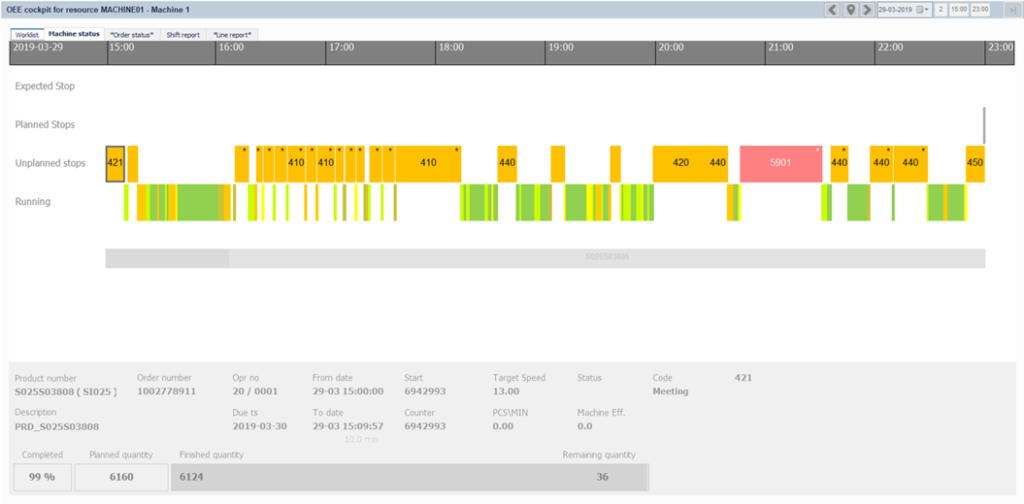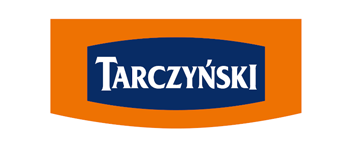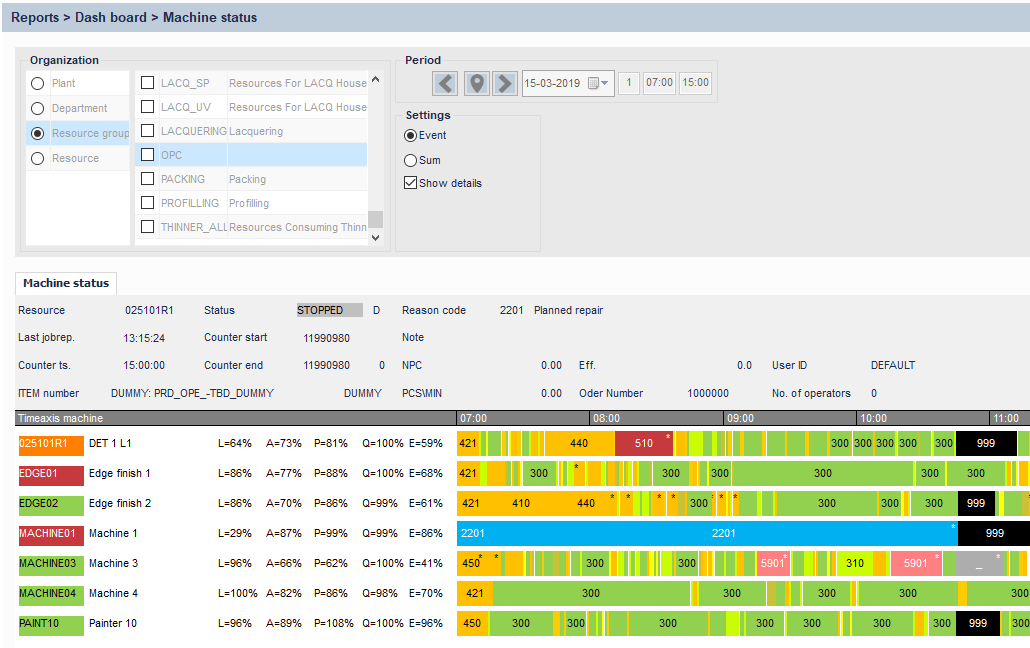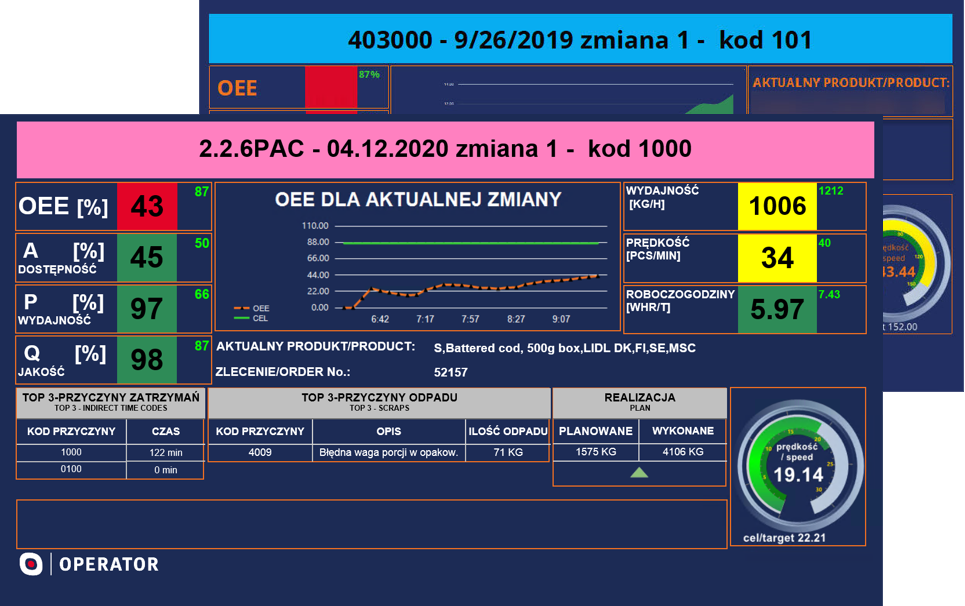Time is money. Thats why the monitoring of production efficiency in Operator OEE is primarily based on the analysis of information obtained directly from the machines.
MES terminals will allow you to refine data, review documentation or run a custom process.
This allows Operator OEE to provide you with a full, up-to-date picture of your production.

Challenge
Industrial production is a very complex process – that much is obvious. It is influenced by a large number of factors – organizational, business, environmental and human. With a certain scale of activity, it is difficult to find the most pressing problems among them and see the hidden potential. We begin to observe only selected parts of the process and base decisions on superficial data, such as the amount of finished items delivered to stock.
The market is demanding ever greater production efficiency, shorter lead times and higher quality. We are trying to meet these demands by launching more initiatives, often result in introducing a new spreadsheets. They often have a fairly short life cycle, consuming a lot of resources for creation and initial updates to hit the shelf a few weeks later.
For our customers, Operator OEE has become the solution to this challenge. It enabled full recording of key events and parameters, and provided tools for their efficient analysis – both on an ongoing basis to respond to unforeseen events and on a long-term basis, which allows, for example, a reliable assessment of total manufacturing costs. Join our customers and build a complete, comprehansive source of production data in you company.




What do you get with Operator OEE?
Operator OEE is a core module in the Operator Platform. Its task is primarily to measure production efficiency using, among other things. Overall Equipment Efficiency(OEE) indicator or Total Effective Equipment Performance(TEEP). Operator OEE acquires its data primarily from two sources:
- The first of these (Machine Operation Status), which allows near real-time performance evaluation, is data extracted from machines via the OPC UA server (read more on this subject → Integration with machines).
- The second is Production Execution – MES terminals – kiosks, computers or mobile devices available to production workers. They make it possible to both enter data and obtain the necessary information to do the job correctly.
In the most successful implementations, the two methods complement each other. Data on starts, stops, downtime codes or yields come directly from the machines into the system – without unnecessary delay. Operators, on the other hand, are able, with the help of MES terminals, to give them the right context, clarify or run the necessary process to avoid losses.
They often involve the Maintenance Department, Quality Control or Production Logistics, which will get the information they need to respond quickly in an efficient and unified way.
Benefits of implementing Operator OEE
- Monitor all the organization’s machines, areas and factories using a uniform, consistent set of indicators.
- Manage production processes based on timely and reliable data.
- Increase production efficiency and resource utilization levels, reduce production cycle time.
- Access to Manufacturing Intelligence – A set of reports, analysis, dashboards provided with the Operator solution.
- Increase employee productivity through simple work instructions and improved communication between departaments.
- Analysis of long-term dependencies and trends, e.g., OEE values for a given product in successive production campaigns.
- Automatic acquisition and aggregation of data from machines (using OPC server) or MES terminals.
- Ability to scale the IT landscape as the company grows and requirements increase.
- Support the smooth implementation and evaluation of the results of initiatives, such as Lean or World Class Manufacturing (WCM).
These are just some of the benefits of implementing an Operator OEE solution. If you’d like to talk about what benefits our customers have achieved and how we can replace spreadsheets with an integrated solution at your factory, click here 
Operating status of machines
- The system monitors the operating status of a machine or station through automatic integration (using, for example, the OPC/OPC UA standard) or manual registration on MES terminals.
- The system creates a time spectrum of the machine showing the status of the operation, such as downtime, failure or reduced efficiency operation.
- Each rectangle corresponds to a time interval for which the work status has not changed. The operator can describe the selected spectrum interval with the appropriate code from a defined list.
- The spectrum will also show those periods where work was done with less than expected efficiency.
- The user can easily change the analysis period and access historical data.

With Operator OEE, you can quickly assess the total efficiency of your plant, production area or a single machine. You can also easily compare machines with each other – across a shift, a day or a week.
The system calculates various production indicators in real time, including, of course, Overall Equipment Efficiency.
Dashboards
Even the most accurate data is worth little if it is not visible in production and does not motivate to act.
OEE Operator includes clear, customizable dashboards that can be displayed on information screens visible to production, maintenance or foremen. The data presented on the dashboards is always up-to-date. They can represent, among other things:
- The target and actual value of the OEE indicator, presented graphically and numerically.
- Information on orders currently in progress.
- Status of the current shift against the plan.
- Status of machines with codes for causes of downtime or failure.
- Information on the level of plan fulfillment.
The information presented on the dashboards can be used both for direct, immediate response to problems and can be discussed during meetings, production briefings to discuss with employees the results achieved.

What is the OEE indicator?
The name of the OEE indicator comes from Overall Equipment Efficiency, which can be translated as Total Resource Efficiency or Total Equipment Efficiency. It is often assumed to be the primary means of evaluating the efficiency of a machine, nest, line, department or entire plant. By efficiency here we mean the use of the time available to us on the machines, the efficiency of their work and the quality thus achieved.
OEE = Availability × Productivity × Quality
The OEE indicator is also the primary tool used in the Operator Platform, where we can observe its level in almost real time, for any machine or area. If you’d like to read more on this topic, we invite you to read our comprehensive article on the indicator
Production Execution
Production Execution is an MES(Manufacturing Execution System) terminal that is part of the Operator Platform. It forms the basis of communication between the production floor and the system. It enables, among other things:
- Production reporting, including reporting on the status of operations (start, stop, finish).
- Reporting on the amount of product produced and additional parameters related to production execution (e.g. temperature, dimensions)
- Advanced waste reporting (so-called outsort management) with support for disposal, adjustments, repairs and re-work.
- Registration and control of employees’ working time.
- Current work status, in the context of a job, machine, resource group or a single order.
- Visual presentation of information about delays, work status, availability of tools or materials.
- Access to material specifications (BOM, Bill-of-material), along with the availability of each BOM item in the warehouse or at another station.
- Sequencing of tasks and assignment of jobs by the foreman.
- Access to technical documentation.
- Support for comments and notes at the order, operation or production station level.
Preview of technical documentation
Production managers are often unaware of the total cost of providing and updating documents available in production. They are often thought of in the category of consumables and paper, overlooking, for example:
- Time spent on printing and distributing documentation.
- The cost of mistakes made by having the wrong documentation (e.g., when changing versions or working with similar details).
- The time spent by the operator to check the specifications of the workpiece – for example, information on what tape to wrap a particular format is available only as the SKU number of that tape on the order card.
Achieving paperlessproduction – where we print only the necessary documents, such as those identifying a detail, is possible with the Operator Platform.
- The MES terminal of the OEE Operator module allows you to view the technical documentation assigned to a machine or production order. It is possible to display various types of documentation, such as manufacturing drawings, changeover instructions, quality control plans, job instructions or instructions received from machine suppliers.
- Documents can be accessed by the operator from any defined context, e.g. order, machine, material, etc.
- We can easily define the source of the documentation. Typically, these are folder structures on network drives or web servers, but we also often perform integrations with systems specific to document storage (e.g. Product Documentation Management – PDM).
- Where necessary – label design and printing can also take place in the Operator Platform. This makes it easier to handle marking and identification of the workpiece or taking samples from production for quality control.
Manufacturing Intelligence
The data collected by the Operator OEE module, both as part of integration with machines and as entered by operators on MES terminal screens, is an invaluable source of information.
It helps our customers build their competitive advantage.
This is possible using the Manufacturing Intelligence module that is part of the Operator Platform, which includes dozens of reports, dashboards and views that present data.
More recently, it has also been available with ACIP(Advanced Continuous Improvement Process), a mechanism for finding the most urgent areas for improvement based on artificial intelligence (AI).
Explore all the possibilities.
Operator Platform
Efficient production requires good cooperation between many areas, including, for example, production logistics, the quality department, planning or maintenance. See how Platform Operator supports our customers in streamlining production.
Let's talk
Our meetings with new clients are always free, without obligation. We also try to make them valuable. We will talk about the specifics of your production → this is key for us to present the right solution 